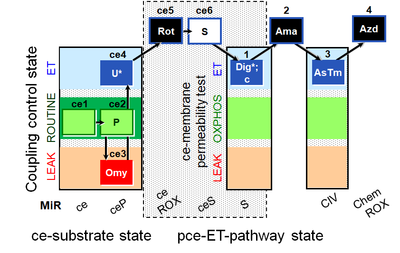Difference between revisions of "Template:SUIT-003 O2 ce-pce D020"
| Line 46: | Line 46: | ||
| ce1;ce2P;ce3Omy;ce4U;ce5Rot | | ce1;ce2P;ce3Omy;ce4U;ce5Rot | ||
{{Template:SUIT ROX}} | |||
|} | |} | ||
| Line 58: | Line 58: | ||
| ce1;ce2P;ce3Omy;ce4U;ce5Rot;ce6S | | ce1;ce2P;ce3Omy;ce4U;ce5Rot;ce6S | ||
{{Template:SUIT S}} | {{Template:SUIT Rot}} {{Template:SUIT S}} | ||
|- | |- | ||
Revision as of 12:53, 19 February 2019
Steps and respiratory states
| Step | State | Pathway | Q-junction | Comment - Events (E) and Marks (M) |
|---|---|---|---|---|
| ce1 | ROUTINE |
ROUTINE respiration in the physiological coupling state R. Externally added permeable substrates could contribute to this respiratory state. | ||
| ce2P | ROUTINE | ce1;ce2P. Pyruvate, ROUTINE, R
ROUTINE respiration in the physiological coupling state R. Externally added permeable substrates could contribute to this respiratory state. | ||
| ce3Omy | L | ce1;ce2P;ce3Omy
Non-phosphorylating resting state (LEAK state); LEAK respiration L(n) in the absence of ADP, ATP, AMP (no adenylates). | ||
| ce4U | E | ce1;ce2P;ce3Omy;ce4U
Uncoupler titration (avoiding inhibition by high uncoupler concentrations) to obtain electron transfer (ET) capacity E (noncoupled ET-state). Test for limitation of OXPHOS capacity P by the phosphorylation system (ANT, ATP synthase, phosphate transporter) relative to ET capacity E in mt-preparations: E-P control efficiency and E-L coupling efficiency. In living cells: E-R control efficiency and E-L coupling efficiency. Noncoupled electron transfer state, ET state, with ET capacity E. | ||
| ce5Rot | ROX | ce1;ce2P;ce3Omy;ce4U;ce5Rot
Rox is the residual oxygen consumption in the ROX state, due to oxidative side reactions, estimated either after inhibition of CIII (e.g. antimycin A, myxothiazol), CIV (e.g. Cyanide) or in the absence of endogenous fuel-substrates. Rox is subtracted from oxygen flux as a baseline for all respiratory states, to obtain mitochondrial respiration. |
| Step | State | Pathway | Q-junction | Comment - Events (E) and Marks (M) |
|---|---|---|---|---|
| ce6S | ce1;ce2P;ce3Omy;ce4U;ce5Rot;ce6S
Succinate pathway control state (S-pathway) after inhibiting CI with rotenone, which also inhibits the F-pathway. Succinate, S ( type S-pathway to Q). | |||
| 1Dig* | SE | S | CII | ce1;ce2P;ce3Omy;ce4U;ce5Rot;ce6S;1Dig
Multiple Digitonin titrations for complete plasma membrane permeabilization. Noncoupled electron transfer state, ET state, with ET capacity E. |
| 1c | SE | S | CII | ce1;ce2P;ce3Omy;ce4U;ce5Rot;ce6S;1Dig;1U;1c
Addition of cytochrome c yields a test for integrity of the mtOM (cytochrome c control efficiency). Stimulation by added cytochrome c would indicate an injury of the mtOM and limitation of respiration in the preceding state without added c due to loss of cytochrome c. Typically, cytochrome c is added immediately after the earliest ADP-activation step (OXPHOS capacity P with saturating [ADP]). Noncoupled electron transfer state, ET state, with ET capacity E. |
| 2Ama | ROX | ce1;ce2P;ce3Omy;ce4U;ce5Rot;ce6S;1Dig;1U;1c;2Ama
Rox is the residual oxygen consumption in the ROX state, due to oxidative side reactions, estimated after addition of antimycin A (inhibitor of CIII). Rox is subtracted from oxygen flux as a baseline for all respiratory states, to obtain mitochondrial respiration (mt). Rox is the residual oxygen consumption in the ROX state, due to oxidative side reactions, estimated either after inhibition of CIII (e.g. antimycin A, myxothiazol), CIV (e.g. Cyanide) or in the absence of endogenous fuel-substrates. Rox is subtracted from oxygen flux as a baseline for all respiratory states, to obtain mitochondrial respiration. |
| Step | Respiratory state | Pathway control | ET-Complex | Comment |
|---|---|---|---|---|
| ## AsTm | AsTmE | CIV | CIV | |
| ## Azd | CHB |
- Bioblast links: SUIT protocols - >>>>>>> - Click on [Expand] or [Collapse] - >>>>>>>
- Coupling control
- Pathway control
- Main fuel substrates
- » Glutamate, G
- » Glycerophosphate, Gp
- » Malate, M
- » Octanoylcarnitine, Oct
- » Pyruvate, P
- » Succinate, S
- Main fuel substrates
- Glossary

